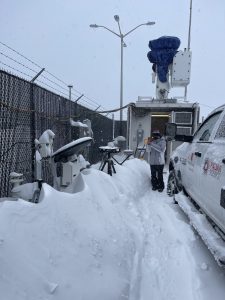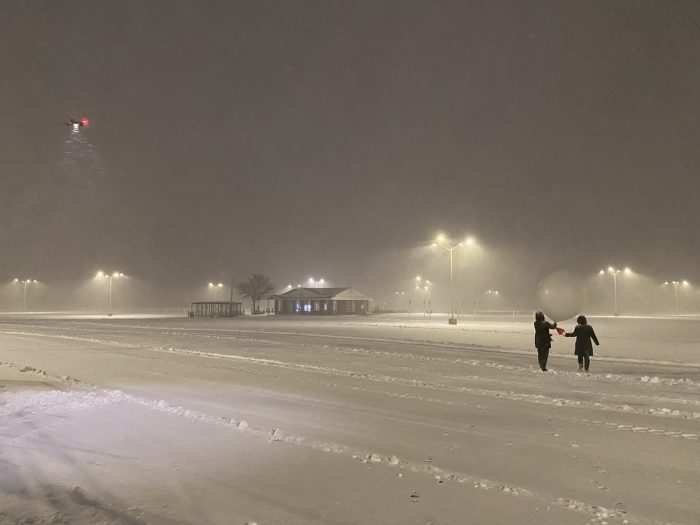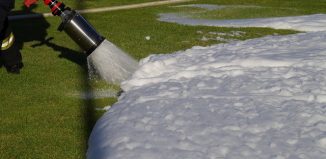SBU weather professors, students launch balloons during nor’easter
By Daniel Dunaief
The hours a few meteorology professors and some of their students spent in driving snow and whipping wind this past weekend amid the nor’easter may improve the accuracy of future weather forecasts.

Even as other Long Island residents were hunkered indoors, Stony Brook University Professors Brian Colle and Pavlos Kollias were teaming up with scientists from several institutions as a part of a three-year NASA-led study called IMPACTS, for The Investigation of Microphysics and Precipitation for Atlantic Coast-Threatening Snowstorms.
The researchers and a group of their students launched weather balloons and gathered radar data from last Friday evening through Saturday night, as the nor’easter named Kenan dumped well over two feet of snow through parts of Long Island.
Stony Brook students helped launch weather balloons every few hours, while NASA sent an ER-2 high altitude airborne plane and a Lockheed P-3 Orion plane into the storm.
“Everyone brings their tools to the sandbox with respect to looking at these storms,” said Colle, who collected data and managed students for over 24 hours.
At 4 a.m., Colle was driving on a road where the lanes and other traffic had disappeared.
“I kind of enjoyed it,” Colle admitted, as he maneuvered along the snow-covered roadway where the lanes completely disappeared.
Colle is in the second year of an IMPACT operation that started in 2020 and was put on pause last year amid the pandemic.
The purpose of the study is to improve forecasting in a one-to-two-day time horizon.
An improvement in the accuracy of localized forecasts over a shorter time can help municipal authorities determine when to send out plows.
“The models can hone in on those features and provide what we refer to as ‘nowcasting’ or short term forecasting,” Colle said. “There’s a big emphasis within the National Weather Service of providing decision support to emergency managers.”
Part of what makes forecasting these storms so challenging is the difficulty in predicting the timing and location of snow bands, which drop large amounts of snow in short periods of time.
In addition to information from the weather balloons, scientists throughout the area gathered temperature, wind and moisture data in places like Brookhaven and Albany.
Researchers ran a few different radar systems probing into the clouds to get more details about how these precipitation bands formed.
During the storm, Colle said the wind shear or the change in wind speed at different altitudes was dramatic, with 10- to 20-knot winds near the ground and 50-knot winds only 500 meters above.
“I was surprised by how strong those winds were, right above our heads,” Colle said.
Colle suggested that the students who participated in gathering data amid a driving snowstorm had the opportunity to apply their textbook learning to a real-world situation.
“The students learn about these measurement approaches in class” but they truly understand it differently when they gather the data themselves, he said.
Student experience
A second-year student in the PhD program at Stony Brook, Erin Leghart, who lives in Farmingdale, worked from 6 p.m. to 2 a.m., which included launching six balloons in about six to eight hours.
Leghart said this was the first time she experienced winds like this in a winter storm.
She was well-dressed for the weather, as she invested in an ankle-length winter coat, snow boots, thermal long johns, Patagonia under armor and ski goggles.
Leghart said the excitement about the storm built about five days before it arrived, as it presented an opportunity to “do a live experiment.”
A sophomore at Stony Brook, Samantha Lankowicz, meanwhile, was excited to join her shift from 7 a.m. to 1 p.m.
“I got to do hands-on science with other students,” she said.
Lankowicz, who loves snow and was hoping for a chance to study a nor’easter this year, was pleased that one of the balloons made it all the way to the stratosphere.
Lankowicz has been to other balloon launches where a snow band turned into rain, which was “not as fun, standing in pouring rain when it’s 34 degrees.”
The only time she felt cold was when she had to take off her ski gloves and put on thinner gloves to handle the balloons.
Also a sophomore, John Tafe, who is from Salem, New York, was fascinated by weather early in life. When he was four years old, he saw clouds on the horizon and predicted a thunderstorm, which not only came later that day, but also knocked out power.
Tafe, whose hands also got cold from handling the balloons, was excited to contribute to the effort.
“To be in such a major storm that hopefully will provide valuable data is exciting,” Tafe said. “I hope that the data we collected will help advance the science.”







